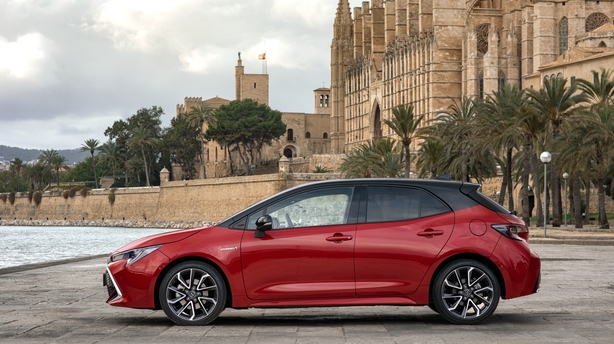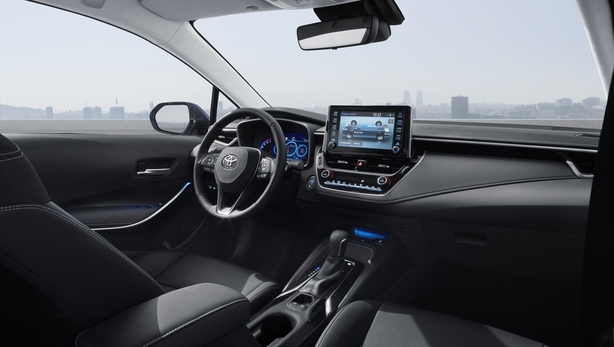Toyota's new Corolla range is both a departure and a challenge for the company and it's the customer who will decide if the direction is the right one. We drive Toyota's new family hybrids - a saloon, a hatchback and an estate.
People don't need to be reminded that the company does'nt do diesel anymore. It's all about self-charging hybrids (cars that have a battery to run on some of the time and a petrol engine to fall back on the rest of the time, and that don't need to be plugged in). They are fuel efficient and they have lower levels of CO2 emissions than most other cars.
Between now and the time electric cars become the norm, it's the hybrid that can attract people put off by charging issues and the cost of electric cars. With hybrid becoming the mainstream of all Toyota production (there is still a petrol choice though), the point of no return has been reached for the interim period at least.
Toyota has done a very nice job in designing the new range and in giving the cars a little emotional appeal they did'nt have previously. The hatchback is quite striking and the saloon looks like a spacious and well put together car. Ironically, the estate version - or the sports tourer to give it its correct title - is perhaps the most innovative and edgy, relatively speaking.

Compared to the Auris, there have been many tweaks. Like many other new cars the Corolla is lower, wider and longer than the Auris it replaces to give it a bit more space and road presence. Overall, you may be surprised to discover one of these cars is a Toyota but, at the same time, you're not going to get over excited about them either. Volume cars designed to be sold around the world tend to conform - none more so than Japanese cars.
One of the most appealing features, however, is the equipping of the car with Toyota's pre-collision assistance programmes. These include a visual and audible alarm when you come too close to a car in front or a pedestrian - either at night or during the day - or a cyclist during the day, the brake force being boosted when the alarm has been sounded and an emergency braking system that kicks in when the driver has not taken action to avoid something. It is a very welcome package and even more so as it is included in the standard price from entry level up. You also get adaptive and intelligent cruise control that prompts you to adjust speed, a lane departure alert that gives you a nudge back into your lane if you stray and a lane tracing programme that keeps you where you should be, even on roads with no markings. Elements of the package are charged as extras by other companies, so Toyota deserves credit for including them at no extra cost.
Prices start at €26,370 for the hatchback, €26,820 for the saloon and €28,420 for the estate or sport tourer.
The main engine is a 1.8 petrol hybrid that produces 120 horse power. It uses a continuously variable transmission, which is basically a gearbox with endless gearing to meet the engine speed. It is not a system everyone likes and if you are the kind of driver who likes to push on at will then you certainly won't like it. It could also be said that if you are fond of a heavy foot on the accelerator then maybe hybrid is not for you. If you push to car too much there is a bit of a boom from the engine and the CVT creates a certain flat response.
Hybrid is an acquired driving style.The more relaxed the style the greater the fuel saving and the fact that the automatic gearbox is flexible means that your fuel savings are all the greater. The Corolla is at its best in the city. My average consumption with the hatchback was 5.2 litres per 100 kilometres, or about 54 miles to the gallon in old money.
You can tweak those figures lower with smoother speeds and careful braking and I did manage 4.3 at one stage (65 MPG). Even the higher figure is impressive, however, when most of the driving was done on motorways and in city conditions. And it's certainly a more impressive figure than most other engines would give, including Ford's much-vaunted 1.0 litre petrol Ecoboost engine.
The driving characteristics of all three cars are quite similiar. I don't believe handling and ride quality are all that important to most drivers unless they are below par. With the Corolla they are not but they don't have the precision of a Ford Focus either.

The interior has been spruced up quite a bit with a little colour tone worked in on the better equipped models. Seats are firm and supportive and have good travel and adjustment in front. When a tall driver extends the seat right back, however, rear leg space becomes very tight. The criterion of manufacturers meeting average requirements need to be borne in mind when looking at the saloon or the hatchback and if you need more space the estate is a better option.
The cabin is also quiet and there's little wind or road noise at speed. The noise comes when you push the engine too hard and when you do you tend to exercise a little more discipline.
There is a standard 4.2 " infotainment screen but Toyota has yet to be provide synching with AppleCarPlay or AndroidAuto, which will really bother some people. It's supposed to be on the way.
At 360 litres the boot is just about adequate and if you need cargo space then the estate is the one to look for.
Overall, the Corolla is a very good package and moves the car into a new space in terms of fuel consumption and CO2 emissions, which are very low at 73 grammes per kilometre - again a figure other manufacturers struggle to compete with. Just remember that hybrid driving needs an adjustment in attitude to get the best out of it. I actually find it's very relaxing and - even if hybrids don't get the same tax breaks as electric cars - environmentally rewarding on a personal level. You feel like your'e doing your bit until the age of the all-electric car.


